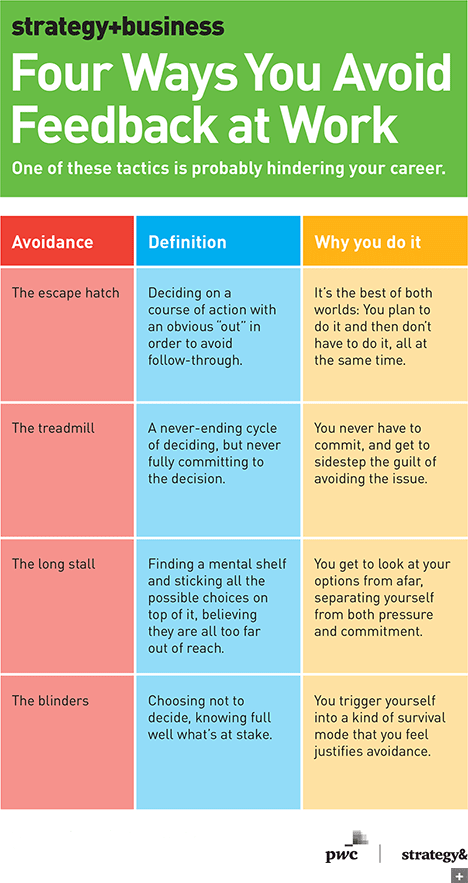Put an End to Your Feedback Loop
Stop avoiding the one criticism that keeps haunting your career. Take our interactive quiz “Why Do You Avoid Acting on Feedback at Work?.”
To be an effective leader, you need to continuously evolve. So, you challenge your own assumptions to avoid blind spots. You stretch your thinking preferences to increase agility. And you invest in others to help them reach their full potential. As a successful leader, you do all of these things — and others — until you don’t.
For many leaders, there is often one specific challenge that stops their progression in its tracks. The most surprising thing? You probably already know what yours is. If you’ve ever said the words “I’ve gotten this feedback before,” chances are you’re playing with fire and undermining your own success by failing to address the issue.
I call these personal examples of legacy feedback “sleeping giants” because they are hidden in plain sight and represent tremendous potential if awakened.
Take Carlos, a midcareer manager in a technology company who sought out leadership coaching after receiving a difficult performance review. He was told by his direct supervisor that his inability to respond to the feedback swiftly could derail his career at the company. I asked Carlos for his perspective on the issue. “My boss called me out on not being engaged with the team,” he said. “And I know it’s true, because when things get hectic and I’m pushed to the brink, I tend to disappear. And when I’m not available for my team, the absence of communication and engagement can cause breakdowns in our collaboration. It just happened on a big project and, as a result, they’re losing trust in me.”
When I asked Carlos how he responded to the feedback, he simply said, “Well, I’ve gotten this feedback before, so it wasn’t a huge surprise.”
Why Do You Avoid Acting on Feedback at Work?
Take this quiz and discover how to address the issue that is holding back your career.
After working with leaders at every level and across a variety of industries, I’m convinced that they know what they need to do — and in most cases, they even know how to do it. But despite all of the best practices, first-class advice, and logical prescriptions intended help resolve their challenges, the solutions are just like an umbrella sitting by the front door when they’ve already rushed out of the house and into the storm.
For Carlos, a sleeping giant was awakened. He not only understood the issue, but was capable of diagnosing the cause and effect of the disappearing act he pulled when things got stressful. The career-defining question was: Why hadn’t Carlos already changed his behavior?
The simple answer: avoidance. In order to take action and prevent the issue from sidetracking his success, I worked with Carlos to identify the origins and nature of his hesitation. If you, like Carlos, are sitting on some vital feedback, consider which of these four typical types of avoidance may be keeping you stuck in your own way.
The escape hatch. This is when you decide on a course of action with an obvious “out” in order to avoid follow-through. It’s attractive because it feels like the best of both worlds: You plan to do it, and then don’t have to do it, all at the same time. Example: You’ve gotten feedback about failing to have difficult but necessary conversations with colleagues. So you say to yourself, “Tomorrow afternoon I’m going to talk to Bob about that stalling project…unless our client keeps us busy with meetings all day. Then I’ll have to find another time.” If you’re reasonably sure that your client is going to keep you busy, then you’ve just installed your escape hatch to avoid that important conversation.
The treadmill. This tactic involves a never-ending cycle of deciding, but never being completely decided. It’s clever because you never have to commit, and there’s a bonus: You get to sidestep the guilt of fully avoiding the issue. Example: You’ve heard time and again that you need to make more of an impact in meetings, so you decide to speak up so that you’re seen and heard. But in meeting after meeting, you hold onto that intention with no specific action step in mind. This partial focus — with no concrete action — may help you feel as if you are moving toward the goal, but you still go nowhere.
The long stall. Here you find a shelf and stick all the possible choices on top of it, well out of reach. You get to safely look at all the options from afar, but you separate yourself from both the pressure and the commitment to do something about it. Example: Both you and your boss realize that you’re ready for a new career challenge and it’s clear to you both that you cannot get that in your current role. Yet you don’t actively seek out opportunities for internal moves, and you magnify the risks of a job search so much that it feels impossible. You’re unhappy, but the steps you could take to put yourself in a better place seem out of reach, so the long stall continues.
The blinders. Brazen and bold, this type of avoidance is deciding not to decide while knowing full well what’s at stake. With this tack, you trigger yourself into a kind of survival mode that justifies avoidance. For example, you’ve been told repeatedly that you need to have better follow-through in order to meet expectations and build greater trust with your client and your team. You’ve always know that “administrative stuff” isn’t your strong suit, so you ignore the small improvements that could give you a needed boost of operational effectiveness. You just blindly hope that your other strengths will be enough to compensate.
If you’ve ever said the words “I’ve gotten this feedback before,” chances are you’re playing with fire.
Once you identify the nature of your avoidance, take the action step that you already know you need to take. If you let your justifications slow you down, you risk stagnating your own development by sitting on the feedback.
This isn’t a message for procrastinators or emerging leaders alone — as a business advisor and leadership coach, I’ve see these tactics up close from even the most motivated, senior leaders. And it’s not another take on the power of giving and receiving feedback — I trust that you’re already striving to do that in most instances. This is about that one, central theme — your legacy feedback — that has shown up for you repeatedly, yet remains neglected.





